seat adjustment Peugeot 208 2015 Owner's Manual - RHD (UK, Australia)
[x] Cancel search | Manufacturer: PEUGEOT, Model Year: 2015, Model line: 208, Model: Peugeot 208 2015Pages: 341, PDF Size: 38.75 MB
Page 52 of 341
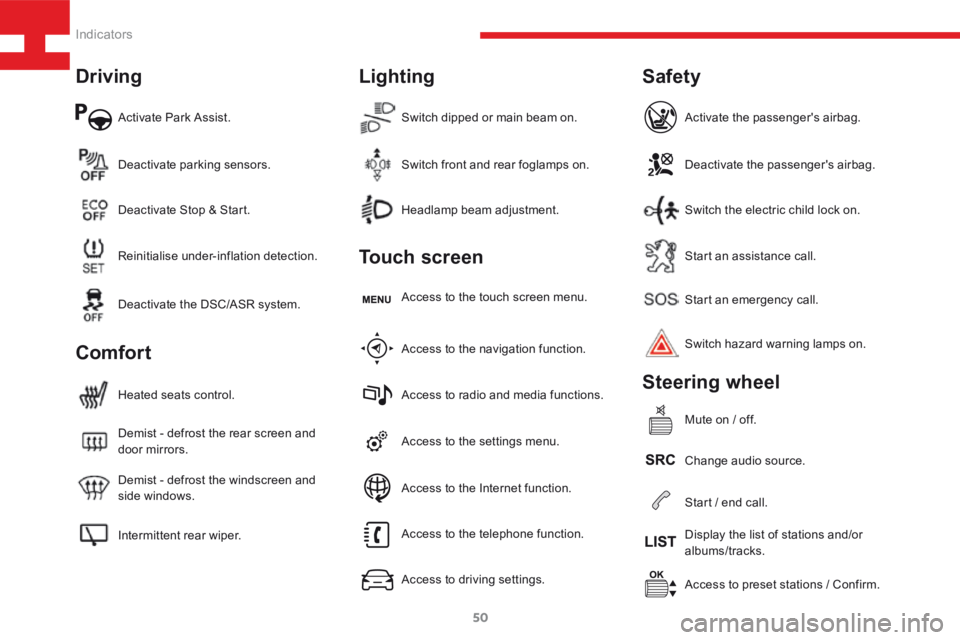
50
208_en_Chap03_Indicateurs_ed01-2015
Activate Park Assist.
Intermittent rear wiper. Demist - defrost the windscreen and
side windows. Demist - defrost the rear screen and
door mirrors. Heated seats control.Access to the settings menu.Start an emergency call.
Access to preset stations / Confirm.
Headlamp beam adjustment.
Deactivate parking sensors.
Access to the navigation function. Access to the touch screen menu.Deactivate the passenger's airbag.
Change audio source. Switch hazard warning lamps on. Activate the passenger's airbag.
Mute on / off.
Switch dipped or main beam on.
Reinitialise under-inflation detection. Deactivate Stop & Start.
Access to radio and media functions.Start an assistance call.
Display the list of stations and/or
albums/tracks.
Switch front and rear foglamps on.
Deactivate the DSC/ASR system.
Access to the telephone function.
Access to driving settings.Switch the electric child lock on.
Start / end call.
Access to the Internet function.
Driving
Comfort Lighting
Touch screen
Safety
Steering wheel
Indicators
Page 63 of 341

61
208_en_Chap04_confort_ed01-2015
Adjusting the steering
wheel
F When stationary , pull the control lever
to release the steering wheel adjustment
mechanism.
F Adjust the height and reach of the wheel to
suit your driving position.
F Push the control lever to lock the steering
wheel adjustment mechanism.
As a safety measure, this operation
must only be carried out with the
vehicle stationary.
PEUGEOT i-Cockpit
Adjustment
To benefit from the ergonomics of the
PEUGEOT i- Cockpit, carry out these
adjustments in the following order:
- height of the head restraint,
- backrest angle,
- seat height,
- longitudinal position of the seat,
- reach and then height of the steering
wheel,
- interior and door mirrors.
Once these adjustments have been made,
ensure that from your driving position you can
see the "head-up" instrument panel clearly,
over the reduced diameter steering wheel.
4
Comfort
Page 64 of 341
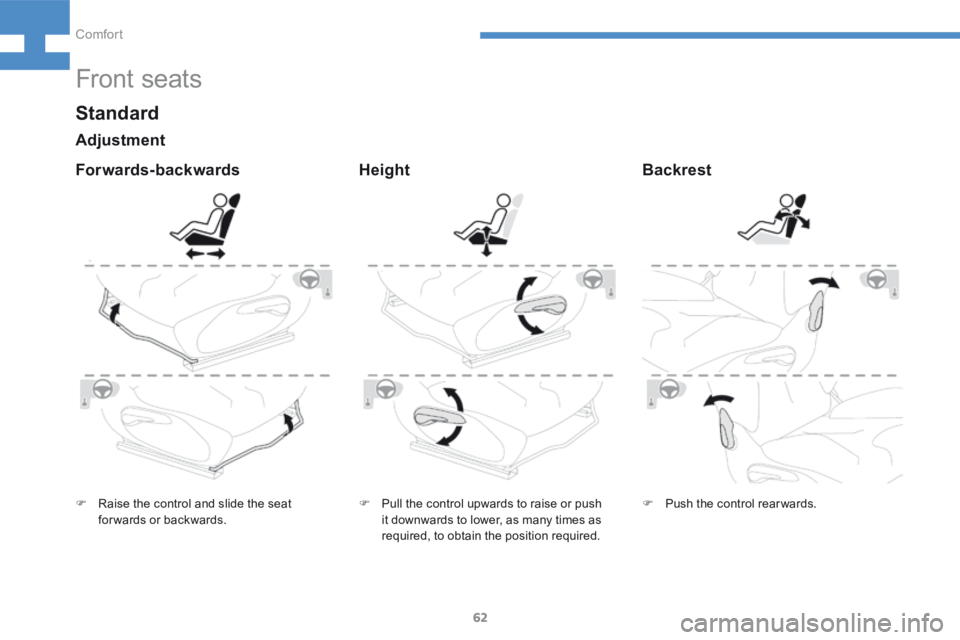
62
208_en_Chap04_confort_ed01-2015
Front seats
F Raise the control and slide the seat
forwards or backwards. F
Pull the control upwards to raise or push
it downwards to lower, as many times as
required, to obtain the position required. F
Push the control rearwards.
Forwards-backwards HeightBackrest
Standard
Adjustment
Comfort
Page 65 of 341

63
208_en_Chap04_confort_ed01-2015
The head restraint has a frame with
notches which prevent it from lowering;
this is a safety device in case of impact.
The adjustment is correct when the
upper edge of the head restraint is
level with the top of the head.
Never drive with the head restraints
removed; they must be in place and
adjusted correctly.
Head restraints
F To raise the head restraint, pull it upwards.
F To remove the head restraint, press the
lug A and pull the head restraint upwards.
F To put the head restraint back in place,
engage the head restraint stems in the
openings, keeping them in line with the
seat back.
F To lower the head restraint, press the lug A
and the head restraint at the same time. Before moving the seat backwards,
ensure that there is nothing that might
prevent the full travel of the seat, so
as to avoid the risk of of jamming the
seat caused by the presence of objects
on the floor behind the seat or rear
passengers. If the seat jams, stop the
movement immediately.
4
Comfort
Page 66 of 341
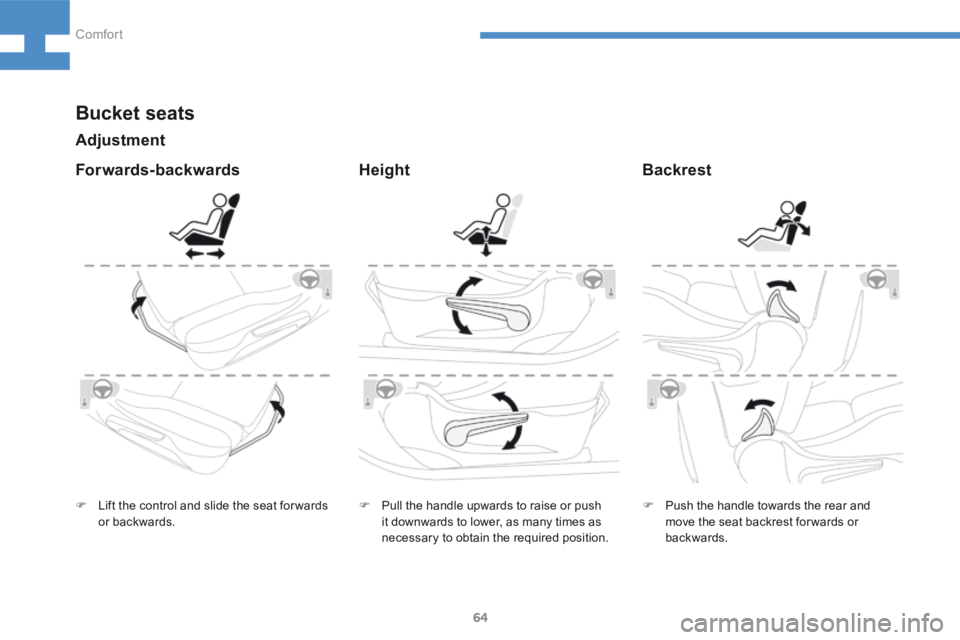
64
208_en_Chap04_confort_ed01-2015
Bucket seats
HeightBackrest
Adjustment
F
Lift the control and slide the seat for wards
or backwards. F
Pull the handle upwards to raise or push
it downwards to lower, as many times as
necessary to obtain the required position. F
Push the handle towards the rear and
move the seat backrest for wards or
backwards.
Forwards-backwards
Comfort
Page 67 of 341
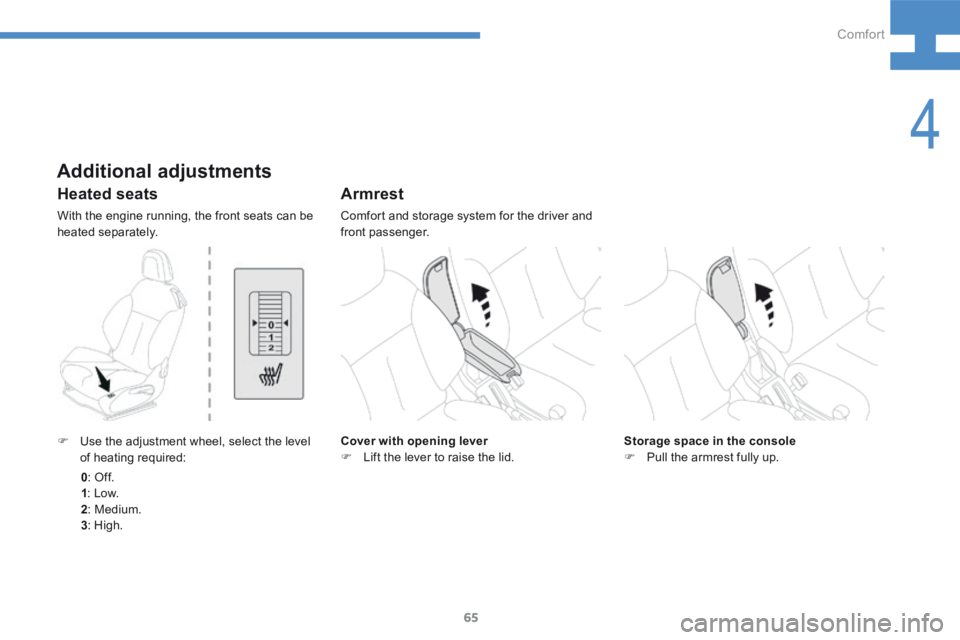
65
208_en_Chap04_confort_ed01-2015
Heated seats
With the engine running, the front seats can be
heated separately.
Armrest
Comfort and storage system for the driver and
front passenger.
Cover with opening lever
F Lift the lever to raise the lid. Storage space in the console
F
Pull the armrest fully up.
Additional adjustments
F Use the adjustment wheel, select the level
of heating required:
0 : Of f.
1 : Low.
2 : Medium.
3 : High.
4
Comfort
Page 90 of 341
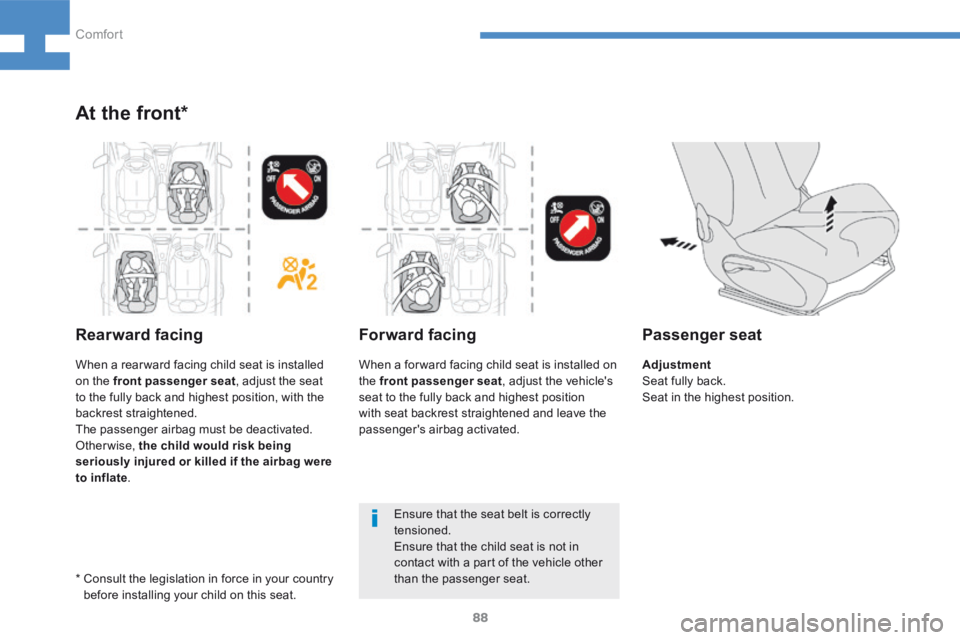
88
208_en_Chap04_confort_ed01-2015
At the front*
Rearward facingForward facing
Ensure that the seat belt is correctly
tensioned.
Ensure that the child seat is not in
contact with a part of the vehicle other
than the passenger seat.
Passenger seat
When a rear ward facing child seat is installed
on the front passenger seat, adjust the seat
to the fully back and highest position, with the
backrest straightened.
The passenger airbag must be deactivated.
Otherwise, the child would risk being
seriously injured or killed if the airbag were
to inflate . When a for ward facing child seat is installed on
the front passenger seat
, adjust the vehicle's
seat to the fully back and highest position
with seat backrest straightened and leave the
passenger's airbag activated.
* Consult the legislation in force in your country
before installing your child on this seat. Adjustment
Seat fully back.
Seat in the highest position.
Comfort
Page 96 of 341
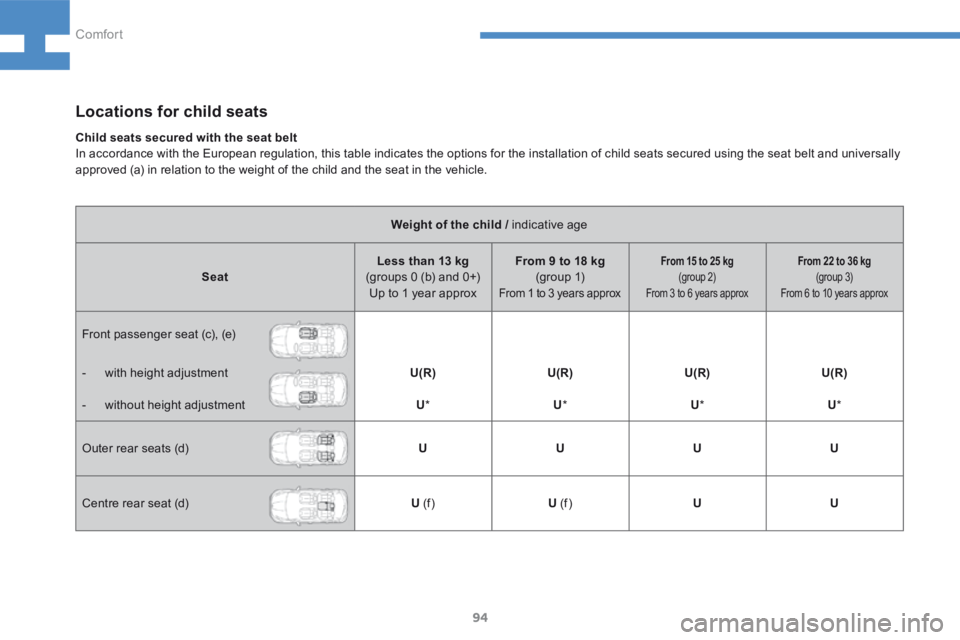
94
208_en_Chap04_confort_ed01-2015
Locations for child seats
Weight of the child / indicative age
Seat Less than 13 kg
(groups 0 (b) and 0+) Up to 1 year approx From 9 to 18 kg
(g r o u p 1)
From 1 to 3 years approx
From 15 to 25 kg
(group 2)
From 3 to 6 years approx From 22 to 36 kg
(group 3)
From 6 to 10 years approx
Front passenger seat (c), (e)
- with height adjustment U(R) U(R) U(R)U(R)
- without height adjustment U* U* U* U*
Outer rear seats (d) UUUU
Centre rear seat (d) U (f )U (f ) UU
Child seats secured with the seat belt
In accordance with the European regulation, this table indicates the options for the installation of child seats secured using the seat belt and universally
approved (a) in relation to the weight of the child and the seat in the vehicle.
Comfort
Page 104 of 341
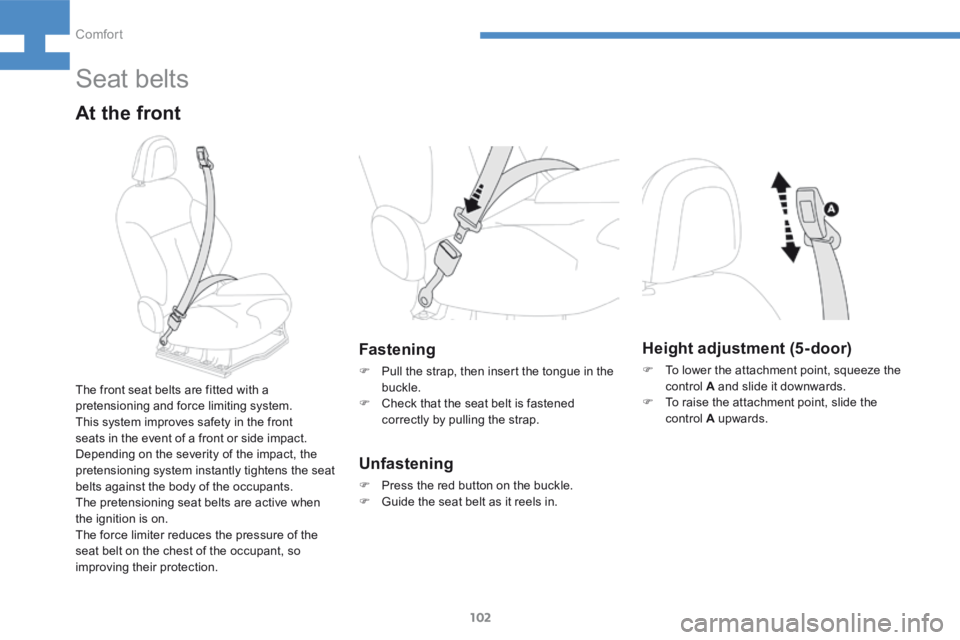
102
208_en_Chap04_confort_ed01-2015
Seat belts
At the front
Fastening
F Pull the strap, then insert the tongue in the
buckle.
F Check that the seat belt is fastened
correctly by pulling the strap.
Unfastening
F Press the red button on the buckle.
F Guide the seat belt as it reels in.
The front seat belts are fitted with a
pretensioning and force limiting system.
This system improves safety in the front
seats in the event of a front or side impact.
Depending on the severity of the impact, the
pretensioning system instantly tightens the seat
belts against the body of the occupants.
The pretensioning seat belts are active when
the ignition is on.
The force limiter reduces the pressure of the
seat belt on the chest of the occupant, so
improving their protection.
Height adjustment (5-door)
F
To lower the attachment point, squeeze the
control A and slide it downwards.
F To raise the attachment point, slide the
control A upwards.
Comfort
Page 106 of 341
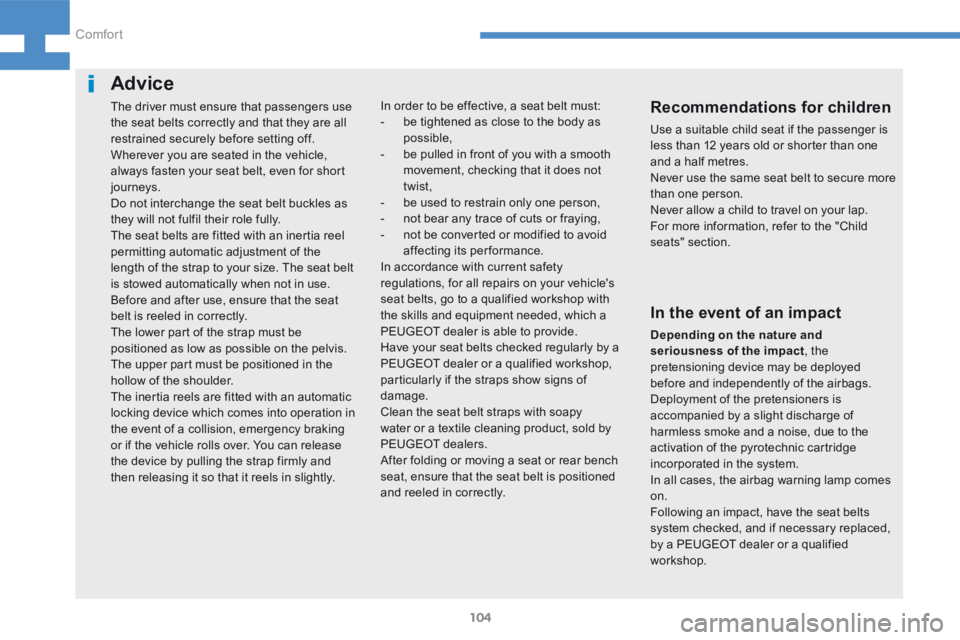
104
208_en_Chap04_confort_ed01-2015
Advice
The driver must ensure that passengers use
the seat belts correctly and that they are all
restrained securely before setting off.
Wherever you are seated in the vehicle,
always fasten your seat belt, even for short
journeys.
Do not interchange the seat belt buckles as
they will not fulfil their role fully.
The seat belts are fitted with an inertia reel
permitting automatic adjustment of the
length of the strap to your size. The seat belt
is stowed automatically when not in use.
Before and after use, ensure that the seat
belt is reeled in correctly.
The lower part of the strap must be
positioned as low as possible on the pelvis.
The upper part must be positioned in the
hollow of the shoulder.
The inertia reels are fitted with an automatic
locking device which comes into operation in
the event of a collision, emergency braking
or if the vehicle rolls over. You can release
the device by pulling the strap firmly and
then releasing it so that it reels in slightly.Recommendations for children
Use a suitable child seat if the passenger is
less than 12 years old or shorter than one
and a half metres.
Never use the same seat belt to secure more
than one person.
Never allow a child to travel on your lap.
For more information, refer to the "Child
seats" section.
In order to be effective, a seat belt must:
-
be tightened as close to the body as
possible,
- be pulled in front of you with a smooth
movement, checking that it does not
twist,
- be used to restrain only one person,
- not bear any trace of cuts or fraying,
- not be converted or modified to avoid
affecting its performance.
In accordance with current safety
regulations, for all repairs on your vehicle's
seat belts, go to a qualified workshop with
the skills and equipment needed, which a
PEUGEOT dealer is able to provide.
Have your seat belts checked regularly by a
PEUGEOT dealer or a qualified workshop,
particularly if the straps show signs of
damage.
Clean the seat belt straps with soapy
water or a textile cleaning product, sold by
PEUGEOT dealers.
After folding or moving a seat or rear bench
seat, ensure that the seat belt is positioned
and reeled in correctly.
In the event of an impact
Depending on the nature and
seriousness of the impact , the
pretensioning device may be deployed
before and independently of the airbags.
Deployment of the pretensioners is
accompanied by a slight discharge of
harmless smoke and a noise, due to the
activation of the pyrotechnic cartridge
incorporated in the system.
In all cases, the airbag warning lamp comes
on.
Following an impact, have the seat belts
system checked, and if necessary replaced,
by a PEUGEOT dealer or a qualified
workshop.
Comfort